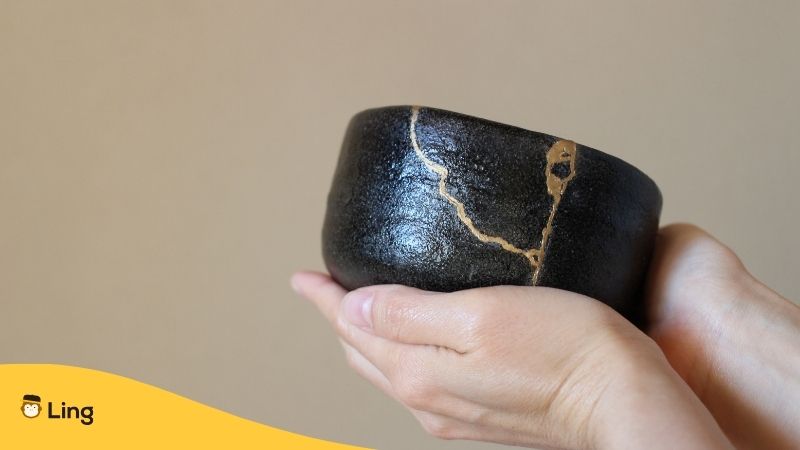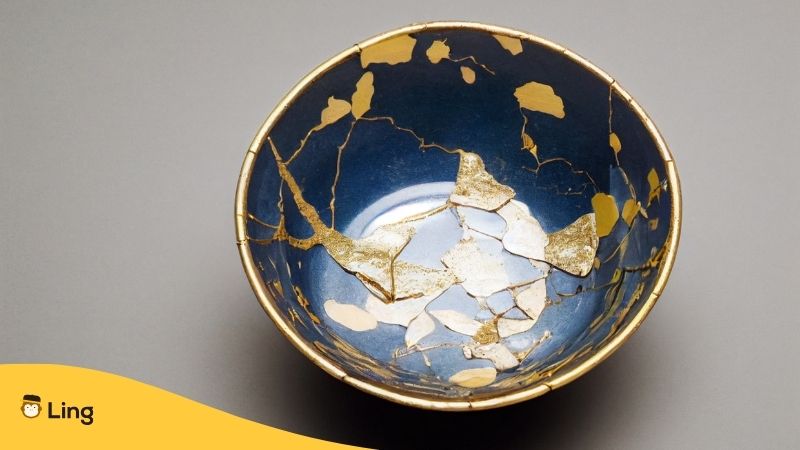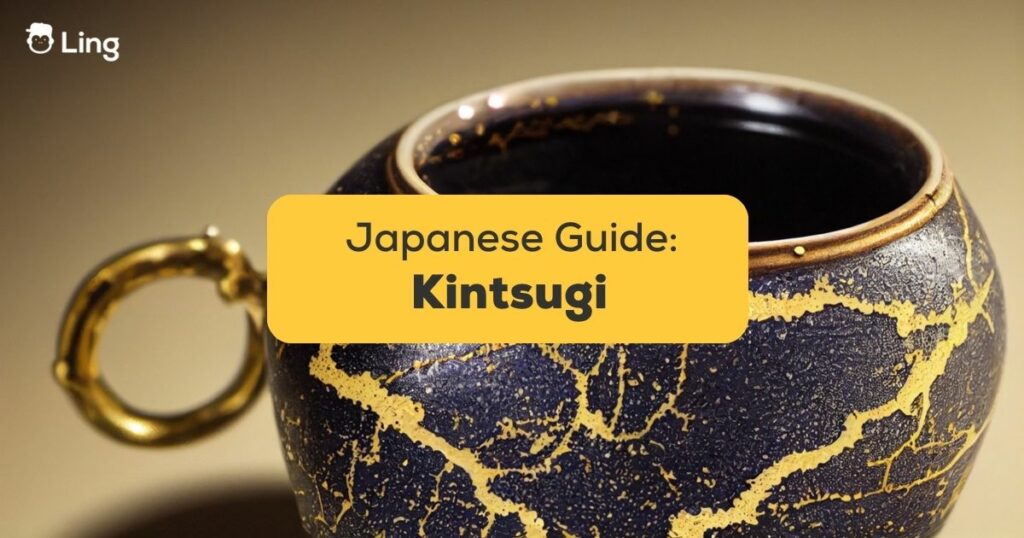Ever seen pottery that shimmers with veins of gold? That is precisely what the Kintsugi in Japanese art looks like. Basically, it’s an age-old technique of fusing broken ceramic pieces back together with a special lacquer made with fancy gold powder.
During my stay in Japan, I learned that the idea of repairing broken pottery isn’t just for the sake of the mottainai culture. It’s actually about the Japanese philosophy of proudly accentuating fractures as embellishments that prove an object’s resilience. This art form isn’t about disguising flaws under filler putty until it looks factory-made!
From then on, I get why things here aren’t replaced when slightly broken or worn when you’re in Japan. And this is what I’ll also share with you today (along with some unique Japanese phrases!).
Table of Contents

What Is Kintsugi In Japanese?
So what exactly is kintsugi in Japanese? Well, broken down, it’s known as “kintsugi” or “kintsukuroi,” which literally translates to “golden joinery.” Here, kin means gold (金), and tsugi means repair (継ぎ).
Essentially it’s this sweet process of taking cracked or shattered pottery and ceramics and piecing them back together using a special lacquer resin blended with powdered gold, silver, or platinum. I know, how rad is that!? Once the broken pieces are rejoined, the resin mixture gently highlights and envelops those fragment lines in beautiful shimmering gold veins.
It’s not about disguising the breaks or making something look “as good as new.” The philosophy in Japan is all about honoring an object’s unique life story and embracing the imperfections that now make it that much more special with a blingin’ touch!
Personally, what I love about this Japanese art form is that no two kintsugi pieces will ever look the same since pottery always cracks and shatters randomly into chaotic patterns! The artists will work painstakingly to match up those distinct fragments so the seams form these badass one-of-a-kind designs reminiscent of lightning bolts, tree branches, spiderwebs, and tributaries.
Pretty epic if you ask me!
The end result becomes this reimagined work of art way more valuable than the original thanks to its gold-dusted history. What a great outlook, right? Our cracks and flaws make us into unique masterpieces!
What Material Is Used For Kintsugi?
When it comes to the craft itself, kintsugi artists use only top-notch materials to repair and embellish broken ceramics. The magic ingredient is the urushi lacquer made from the sticky sap harvested from Japanese lacquer trees. I gotta warn ya, though – that stuff is nasty until it’s cured! It’s toxic to touch in its raw state and takes weeks to set and harden in humid conditions. Most shops keep rows of freshly-repaired pots wrapped in linen and Bamboo, drying for days before unveiling the final product.
Once cured, urushi lacquer can withstand boiling water and has kickass bonding strength to fuse the pottery fragments. The classics use powdered gold, silver, or platinum blended into the urushi to form that iconic veined effect, but I’ve also seen crazy cool interpretations incorporating pearls, seashells, and crushed gems for custom-commissioned pieces.
Part of kintsugi’s appeal is it rejects the quick n’ dirty route. Everything about it requires Jedi levels of focus, patience, and precision. That meticulous craftsmanship shines through in the showstopping results that look insanely expensive but won’t bankrupt ya. Just don’t try patching up your smashed plates after a rowdy dinner party with Elmer’s glue and glitter from a grade school art cabinet!
Best Types Of Pottery For Golden Repair?
Now I know repairing century-old tea bowls and lacquered ware sounds fancy, but get this – even run-of-the-mill pottery can score spectacular kintsugi makeovers! I’m talking everyday plates, bowls, and mugs in standard 8 to 15 cm sizes.
While the Japanese masters source prime native clay and porcelain for that ultimate stage presence, none of that matters if the foundation craftsmanship’s weak. In the right hands, even basic ceramic dishes or clay pots can morph into next-level glam with the right golden-laced magic.
@chimahaga Behind the scenes of #KINTSUGI This is the food-safe method. #金継ぎ #金繕い #金継ぎ教室 #手仕事 #kintsugiart #kintsukuroi
♬ Aesthetic – Tollan Kim
How To Kintsugi Like A Pro
What You’ll Need
Before you channel your inner kintsugi master, gather these handy supplies:
- Broken ceramic ware (bowls, plates, mugs)
- Kintsugi repair kit or:
- Clear ceramic adhesive
- Mica, silver, or gold powder (for mixing into lacquer)
- Liquid gold leaf
- Small disposable paintbrushes
- Masking tape
- Craft/tissue paper
- Clay or epoxy mixture (for missing piece repairs)
- Small scrap paper (to mix lacquer)
- Drop cloth (work surface protection)
- Soft rag
- Small container or jar (for homemade lacquer)
- Toothpicks (for lacquer application)
That covers the key gear for pulling off pro-level golden repairs! Once your kintsugi materials are assembled, it’s go time!
Step 1: Pick Your Broken Pottery
First up, scour your cupboards for shattered ceramic bowls, mugs, plates, and vases begging for some golden healing! Opt for purely decorative pieces rather than dinnerware since the lacquer can leach toxic stuff. Then determine if it’s a clean break or chunks missing to pick the right repair method.
Step 2: Select Your Kintsugi Style
If it snapped perfectly in half, the “crack” technique works great. Just fuse the edges with lacquer and let gold powder or leaf highlight the seam. For missing shards, the “joint” or “Makienaoshi” methods rebuild it by packing spaces with lacquer-soaked paper or a clay mixture shaped to fit.
Step 3: Make the Magic Lacquer
Either grab a kintsugi kit with premade urushi lacquer or DIY it by mixing clear ceramic adhesive with mica powder. The basics are 2 parts glue to 1 part mica but adjust to get the perfect molten gold consistency. Stir that pot on scrap paper since this sticky potion dries fast!
Step 4: Bond Your Fragments
Paint broken edges with the luscious lacquer, press the pieces together, and hold for a few minutes till semi-dry. For missing sections, mask off areas on intact edges, and fill gaps with lacquer mounds to match the missing contours. Remove masking once firm.
Step 5: Add Golden Accents
If mica’s mixed in, cracks will shimmer on their own. But extra sprinkled powder or liquid gold leaf really makes repairs pop! For leaf application, wait till fully cured to paint liquid adhesive on seams, apply foil, and seal with a final lacquer layer.
Step 6: Seal & Protect Your Masterpiece
Multiple lacquer coats to seal the beauty! Display with pride knowing imperfections now shine brighter than ever with their handcrafted metallic embroidery!

Japanese Phrases For Kintsugi
Wabi Sabi
This core concept of embracing imperfect beauty and transience captures Kintsugi’s heart. Repeat “wabi-sabi” when admiring repaired works to signal deep appreciation.
Kintsukuroi
Give golden repair its proper due by accurately namedropping “kintsukuroi,” one term for the technique. The approval beams from craftsmen will glow brighter than any lacquer!
Tomete kudasai
Can’t resist grabbing museum-quality ceramics in shops? Politely ask “tomete kudasai” (Please stop me!) to curb temptation! Wouldn’t want 500 years of history shattering!
Kirei desu ne?
Rave over a particularly dazzling kintsugi piece with “kirei desu ne?” (It’s beautiful, isn’t it?). Watch artist’ egos glow as golden as their repairs!
Ready To Try Other Ceramic Repair Techniques?
Before you raid the recycling for test pieces, why not master a few more ceramic repair tricks to add to your jewelry box? From decadent gold leaf applications to weaving luscious lace patterns across fractures, there’s a whole world of knockout techniques perfect for upping your kintsugi game.
Want the inside scoop on cultural topics like these? Just download the Ling app to unlock the Japanese language course. With every bite-sized lessons, you’ll discover cultural topics and grammar lessons to fully improve your skills. Give it a try now!































































